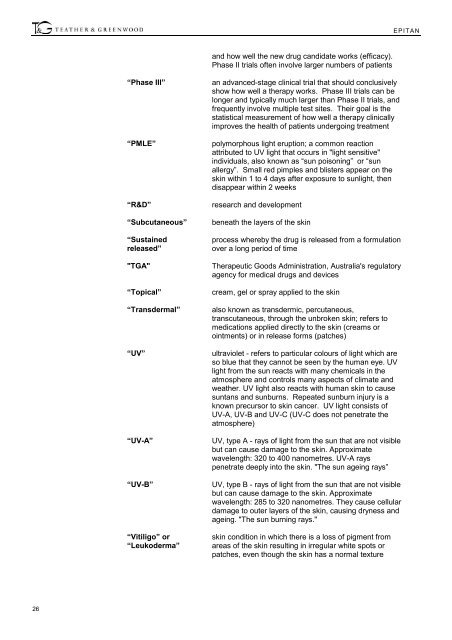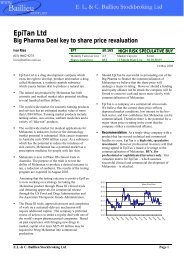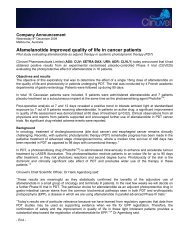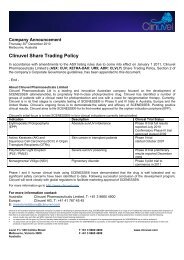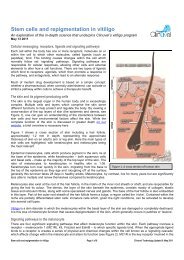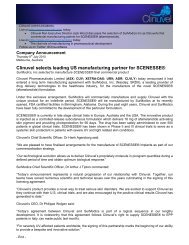<strong>EPITAN</strong>and how well the new drug candidate works (efficacy).Phase II trials often involve larger numbers of patients“Phase III”“PMLE”“R&D”“Subcutaneous”“Sustainedreleased”"TGA"“Topical”“Transdermal”“UV”“UV-A”“UV-B”“Vitiligo” or“Leukoderma”an advanced-stage clinical trial that should conclusivelyshow how well a therapy works. Phase III trials can belonger and typically much larger than Phase II trials, andfrequently involve multiple test sites. Their goal is thestatistical measurement of how well a therapy clinicallyimproves the health of patients undergoing treatmentpolymorphous light eruption; a common reactionattributed to UV light that occurs in "light sensitive"individuals, also known as “sun poisoning” or “sunallergy”. Small red pimples and blisters appear on theskin within 1 to 4 days after exposure to sunlight, thendisappear within 2 weeksresearch and developmentbeneath the layers of the skinprocess whereby the drug is released from a formulationover a long period of timeTherapeutic Goods Administration, Australia's regulatoryagency for medical drugs and devicescream, gel or spray applied to the skinalso known as transdermic, percutaneous,transcutaneous, through the unbroken skin; refers tomedications applied directly to the skin (creams orointments) or in release forms (patches)ultraviolet - refers to particular colours of light which areso blue that they cannot be seen by the human eye. UVlight from the sun reacts with many chemicals in theatmosphere and controls many aspects of climate andweather. UV light also reacts with human skin to causesuntans and sunburns. Repeated sunburn injury is aknown precursor to skin cancer. UV light consists ofUV-A, UV-B and UV-C (UV-C does not penetrate theatmosphere)UV, type A - rays of light from the sun that are not visiblebut can cause damage to the skin. Approximatewavelength: 320 to 400 nanometres. UV-A rayspenetrate deeply into the skin. "The sun ageing rays”UV, type B - rays of light from the sun that are not visiblebut can cause damage to the skin. Approximatewavelength: 285 to 320 nanometres. They cause cellulardamage to outer layers of the skin, causing dryness andageing. "The sun burning rays."skin condition in which there is a loss of pigment fromareas of the skin resulting in irregular white spots orpatches, even though the skin has a normal texture26
Teather & Greenwood Limited (“Teather & Greenwood”) has been appointed to act as the exclusive nominated adviser and broker toEpiTan Limited (“EpiTan”) in connection with the proposed admission of EpiTan’s entire share capital to trading on the AlternativeInvestment Market of the London Stock Exchange plc (the “Flotation”).This report has been prepared independently of EpiTan and has not been prepared by, at the instigation of or by arrangement with theCompany or any of its directors and the information, opinions and projections in this report are entirely those of Teather & Greenwood aspart of its internal research activity and not as an agent of EpiTan or any other person. In particular, any opinions, estimates, projectionsor forecasts in this report are, unless otherwise attributed, entirely those of Teather & Greenwood as part of its normal research activitiesand do not represent those of EpiTan or any other person. There can be no assurance that future results or events will be consistentwith any such opinions, estimates, projections or forecasts. Teather & Greenwood has no authority whatsoever to give any informationor make any representation or warranty on behalf of EpiTan or any other person in connection with the Flotation or otherwise.This document does not constitute, or form part of, any offer of or sale or subscription of or solicitation of any offer to buy or subscribe forany securities, nor should it or any part of it form the basis of or be relied on in connection with any contract or commitment whatsoever.Any decision to apply for securities in EpiTan should be made solely on the basis of information contained in the final admissiondocument to be published in respect of the Flotation and no reliance should be placed on any information other than that contained inthe final admission document.While all reasonable care has been taken to ensure that the facts stated in this report are accurate and that the forecasts, opinions andexpectations contained herein are fair and reasonable, none of EpiTan, Teather & Greenwood nor any other person has independentlyverified the contents of this document. Accordingly, no representation or warranty, express or implied, is made as to the fairness,accuracy, completeness or correctness of the information and opinions contained in this document and no reliance should be placed onsuch information or opinions. The information and views given in this document are subject to change without notice and may notcontain all material information concerning EpiTan and its affiliates. To the extent permitted by law and regulation, none of EpiTan,Teather & Greenwood or any of their respective members, directors, officers or employees nor any other person accepts any liabilitywhatsoever for any loss howsoever arising from any use of this document or its contents or otherwise arising in connection therewith.Teather & Greenwood and its respective affiliates and/ or its officers, directors or employees may from time to time purchase, subscribefor, add to or dispose of, any securities in EpiTan (or may have done so before publication of this report) or make a market or act asprincipal in any transactions in such securities.In the United Kingdom, this communication is directed only at persons reasonably believed by Teather & Greenwood to be of a kind towhom this document may, for the time being, be communicated pursuant to certain exemptions from Section 21 of the FinancialServices and Markets Act 2000, namely:(i)(ii)(iii)(iv)persons having professional experience in matters relating to investments, that is investment professionals who fall within Article19 of the Financial Services and Markets Act 2000 (Financial Promotion) Order 2001, as amended (the “Order”); orhigh net worth companies, unincorporated associations etc. who are persons falling within Article 49 of the Order; orpersons who are intermediate customers or market counterparties (as defined by the FSA Rules); orany person to whom this document may otherwise be lawfully communicated, (all such persons together being referred to as“Relevant Persons”).This communication must not be acted on or relied on by persons who are not Relevant Person. Any investment or investment activityto which this communication relates is available only to Relevant Persons and will be engaged in only with relevant persons.Neither this document nor any copy of it may be taken or transmitted into the United States of America, its territories or possessions (the“United States”) or distributed, directly or indirectly, in (the “United States”) or to any US person (as defined in Regulation S under theUS Securities Act of 1933, an amended (the “Securities Act”)), including any resident of the United States or any corporation,partnership or other entity created or organised under the laws of the United States. The shares in EpiTan have not been registeredunder the Securities Act and may not be offered or sold within the United States or to, or for the account or benefit of, US persons,except pursuant to an exemption from, or in a transaction not subject to, the registration requirements of the Securities Act.Neither this document nor any copy of it may be taken or transmitted into Australia, Canada or Japan or distributed or re-distributed inAustralia, Canada or Japan or to any individual outside Australia, Canada or Japan who is resident of any of Australia, Canada orJapan.The distribution of this document in other jurisdictions may be restricted by law and persons into whose possession this documentcomes should inform themselves about, and observe, any such restrictions. Any failure to comply with these restrictions may constitutea violation of Australian, Candian, Japanese, United Kingdom or United States securities laws or any such other jurisdiction.This document and its contents are confidential and are being supplied to you solely for your information and shall not be distributed,published or reproduced (in whole or in part) or disclosed by recipients to any other person for any purpose. This document must not bedistributed or passed on, directly or indirectly, to or acted on by the press or other media organisation. By accepting receipt of thisdocument, you agree to be bound by the limitations and restrictions set out above.


